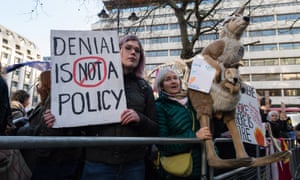The need for emissions cuts is urgent – the longer we wait, the more of our carbon budget we use
We
are quickly running out of time to act on climate change because
governments across the world, led by our own intransigent, denying
government are failing to focus on cutting emissions. The biggest
problem with the prime minister’s shift towards blaming the states and
doing all he can to avoid actual emissions cuts is he continues to make
it even harder for future governments to undo his damage.
Let us never again suggest this government might be about to take climate change seriously. Scott Morrison has taken the view that saying he believes in climate change is enough to avoid any suggestion that he is in fact a climate change denier.
In reality he is like a bloke who says he is against drink-driving, but then tells his mates the way to drive home from the pub without getting caught by the cops.
No one who believes in climate change would continue to boast of
Australia’s record on emissions reductions. And no one would also say,
as he did on Tuesday on Sky News, “hazard reduction is as important as
emissions reduction and many would argue, I think, even more so”.Let us never again suggest this government might be about to take climate change seriously. Scott Morrison has taken the view that saying he believes in climate change is enough to avoid any suggestion that he is in fact a climate change denier.
In reality he is like a bloke who says he is against drink-driving, but then tells his mates the way to drive home from the pub without getting caught by the cops.
And remember, he is not just talking about hazard reduction burning, but actual land clearing.
I guess you can’t have bushfires if you have no bush.
The problem however is that the government’s intransigence on climate change is not something that can just be forgotten should they lose the next election.
C02 emitted in one year doesn’t vanish when the calendar flips to 1 January – it remains in the atmosphere, and at a certain point the total amount will have us at a point of no return.
All the talk about needing to cut emissions by 45% from 2010 levels by 2030 in order to keep temperatures from rising 1.5C over pre-industrial levels is based on the view of the world’s “carbon budget” and how much we have remaining.
Think of it like having $1,500 to spend in a month. If you spend $50 a day, you’ll be fine, but if you spend $75 a day, you will have to live on nothing for the last 10 days.
The world is estimated to be able to emit a certain amount of cumulative emissions before we reach a point where hitting 1.5C and then 2C is inevitable.
Given the amount the world has emitted since the industrial revolution, the IPCC estimates if we keep going at our current levels we will hit our budget limit for 1.5C in about 10 years.
The recommendation for 45% cuts by 2030 and to 0% by 2050 are all based around keeping within the carbon budget.
This means that the important thing is not being 45% below 2010 levels in 2030, but that a 45% cut by then should be enough – but only if we start now.
If we start later, we will need deeper cuts, otherwise we will go over our carbon budget.
It’s also why Anthony Albanese’s statement about future targets is a bit troubling.
In his interview on Sunday with Sky News’s Andrew Clennell he very much hedged about what the ALP’s target for emissions cuts would be, and suggested “I think it was a mistake in 2019 to continue to say, ‘Well, we’ll do exactly what we’re doing in 2015’, as if it hadn’t changed”.
He is right, but the problem is he does not seem to be indicating that what has changed means the cuts will have to be greater.
The government currently is estimating the path to a 26% cut in emissions from 2005 levels by 2030 will start from a level of 509 Mt C02e in 2020 and reduce emissions by 5.6Mt each year until hitting 452Mt in 2030.
So in effect the government has stated its carbon budget for this decade is 5,286Mt.
But the current projection is for us to emit 534Mt this year. So, straight off the bat we are 25Mt over budget. That necessarily means (assuming we want a nice linear path) if we are to keep within our budget we will have to end in 2030 at a level lower than 452Mt.
In fact it would be 427Mt.
The problem for the ALP is this makes getting to 45% even tougher.
Let’s say they win in 2022. It would be difficult to make any great changes that come into effect before the end of 2023, so let’s lock in the projections until then.
Given a 45% cut means a smaller 10-year budget (just 4,675Mt), this would mean to keep within that budget we would need to have a 2030 target of just 252Mt – some 59% below 2005 levels:
For all his blather about adaptation, as Morrison ignors the need for emissions cuts, he is not only letting down people now, he is ensuring it will be harder to adapt to a low carbon economy in the future.
• Greg Jericho writes on economics for Guardian Australia

No comments:
Post a Comment